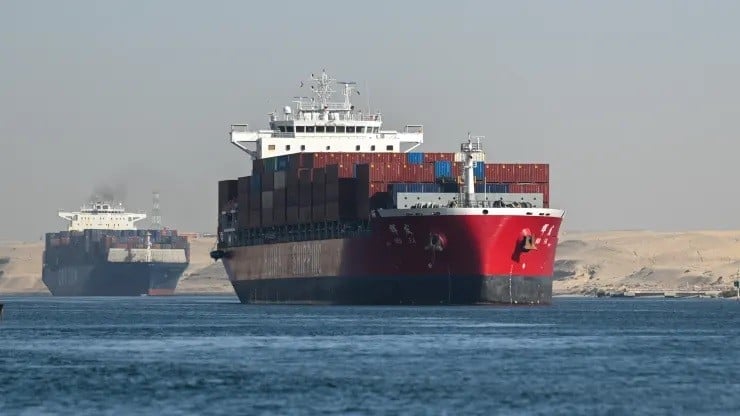 |
| Oil prices are expected to rise to $90 a barrel if the Red Sea crisis continues to escalate. (Source: Getty IMages) |
The global oil market is becoming increasingly localized. As Houthi attacks fuel a crisis in the Red Sea, pushing up shipping rates and insurance premiums, oil buyers are looking for supplies closer to home for supply stability.
The market is increasingly localized
On February 4, some oil tankers were still passing through the Red Sea route, but they were rerouted around the Cape of Good Hope, south of Africa, making the journey longer and more expensive. This led to a rapid decline in tanker traffic through the Suez Canal.
Instead, tankers are concentrating in two directions. The first is around the Atlantic Basin, including the North Sea and the Mediterranean. The second is around the Persian Gulf, the Indian Ocean and East Asia.
What is happening clearly demonstrates the changing paradigm in oil trading. According to traders, since last month, some European refiners have stopped buying Iraqi Basrah crude and switched to buying from suppliers in the North Sea and Guyana.
In Asia, demand for UAE Murban crude surged, leading to a surge in spot oil prices from the region in mid-January, offsetting a sharp drop in oil flows from Kazakhstan to Asia.
Experts say the fragmentation in the oil market is not expected to last, but for now it is making it more difficult for countries that rely on imported oil such as India and South Korea to diversify their oil supplies.
For refiners, fragmentation limits their flexibility to respond to rapidly changing market dynamics and can ultimately reduce profitability.
“The shift to closer oil sources makes important commercial sense,” said Viktor Katona, chief crude oil analyst at Kpler. “It ensures a stable supply for buyers and this will continue as long as disruptions in the Red Sea, which have driven up freight rates, persist. The market’s response is a difficult balancing act, choosing between security of supply and maximizing profits.”
According to data released by Kpler on January 30, the number of oil tankers passing through the Suez Canal in January fell by 23% compared to November 2023. The decline was even more pronounced for ships carrying liquefied petroleum gas and liquefied natural gas, with declines of 65% and 73%, respectively.
Among product markets, diesel and jet fuel flows from India and the Middle East to Europe, as well as European fuel oil and naphtha exports to Asia, were most affected.
Last week, Asian naphtha prices, a petrochemical feedstock, hit their highest in nearly two years, on concerns that supplies from Europe will become more tight.
Oil prices could climb to $90 a barrel?
According to economic experts, the Red Sea crisis is the reason for pushing world oil prices to their current high levels. Without the disruption in shipping activities, factors such as the economy of China - the world's largest oil buyer - and doubts surrounding the strategy of the Organization of the Petroleum Exporting Countries (OPEC) would have pushed oil prices down by about 2% compared to current prices.
On the first day of February, the price of North Sea Brent crude oil was trading at $77.33/barrel, while the price of US light sweet crude oil (WTI) stopped at $72.28/barrel. Excluding geopolitical instability, observers believe that the actual price of oil should only fluctuate around $70-75/barrel.
Explaining this, experts said that most of the important market forces are pulling oil prices down. Analyst Rebecca Babin, from CIBC Asset Management, said: "Although it seems that oil prices have not fallen significantly, it is clearly being held back by a fundamental weakness."
That weakness stems from slowing demand in China and a glut of oil in the market, as non-OPEC countries continue to expand production.
Despite recording 5.2% growth in 2023, China’s economy is showing signs of slowing, especially in the real estate and investment sectors. According to Babin, the weak demand outlook for the world’s top oil importer will be the biggest threat facing the global oil market in 2024.
Furthermore, OPEC is another force that is driving down oil prices. The production cuts by the organization, led by Saudi Arabia and Russia, have not been effective in boosting oil prices. Markets are now skeptical about whether OPEC will soon lift the production cuts, given the increasing competition for oil supplies as non-OPEC members increase production.
This explains why the Red Sea tensions are the only reason for the rise in oil prices. In an update note on February 1, Babin explained that oil supplies have not decreased significantly due to the escalation of tensions in the Middle East. Therefore, oil is not priced based on a lack of supply, but higher transportation costs have supported prices. The estimated impact of increased costs related to transportation/insurance around the Red Sea region on oil prices is around $2-3.
“Technically there has been no disruption to supply, but the longer delivery times are what is pushing prices up slightly,” said Hunter Kornfeind, an analyst at Rapidan Energy.
Expert Babin estimates that if tensions in the Red Sea do not end soon, oil prices could likely climb to $90 per barrel in the near future.
Source


![[Photo] Close-up of Vietnam's sniffer dog team searching for earthquake victims in Myanmar](https://vstatic.vietnam.vn/vietnam/resource/IMAGE/2025/4/1/d4949a0510ba40af93a15359b5450df2)

![[Photo] Third meeting of the Organizing Subcommittee serving the 14th National Party Congress](https://vstatic.vietnam.vn/vietnam/resource/IMAGE/2025/4/2/3f342a185e714df58aad8c0fc08e4af2)


![[Photo] Relatives of victims of the earthquake in Myanmar were moved and grateful to the rescue team of the Vietnamese Ministry of National Defense.](https://vstatic.vietnam.vn/vietnam/resource/IMAGE/2025/4/2/aa6a37e9b59543dfb0ddc7f44162a7a7)

























































































Comment (0)